

A maxi trimaran for Edmond de Rothschild
Construction: 2016 Launch date: July 2017 Shipyard: Multiplast / Lorima / Persico Architects: Team Verdier (Guillaume Verdier, Morgane Schlumberger, Hervé Penfornis, Romaric Neyhousser), Bobby Kleinschmit (Team New Zealand), Bureau d’études Gitana (Antoine Koch, Marine Villard, Sébastien Sainson, Armand de Jacquelot, Julien Marcelet), Pure Design Skipper: Sébastien Josse Racing program: solo-racing
@gitana-team.com
A trimaran measuring 32-metres in length and 23 metres in width, this ‘Ultime’ once again bears witness to the passion for innovation and performance, that serves as a daily guide to Ariane and Benjamin de Rothschild and the rest of the Gitana Team. They created the offshore racing stable in 2000, ensuring continuity with the team that has undertaken research and assisted with the development of the Multi70 Edmond de Rothschildl, since 2014.
Designed by Guillaume Verdier, alongside his team and the Gitana design office; the Maxi Edmond de Rothschild will be partly Archimedean boat (submerged hull) and flying craft. Gitana Team’s game plan is to develop the first flying maxi-multihull in offshore racing, by 2020.
@Gitana-team.com
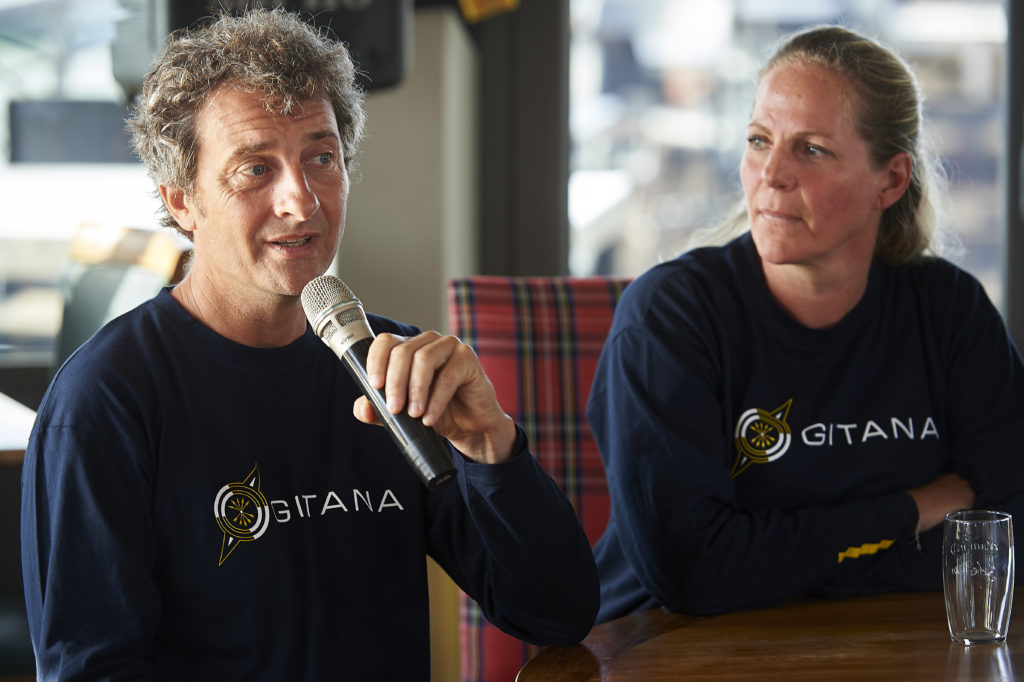
Vannes le 17 juillet 2017, chantier Multiplast, sortie et mise à l’eau du Maxi Edmond de Rothschild.
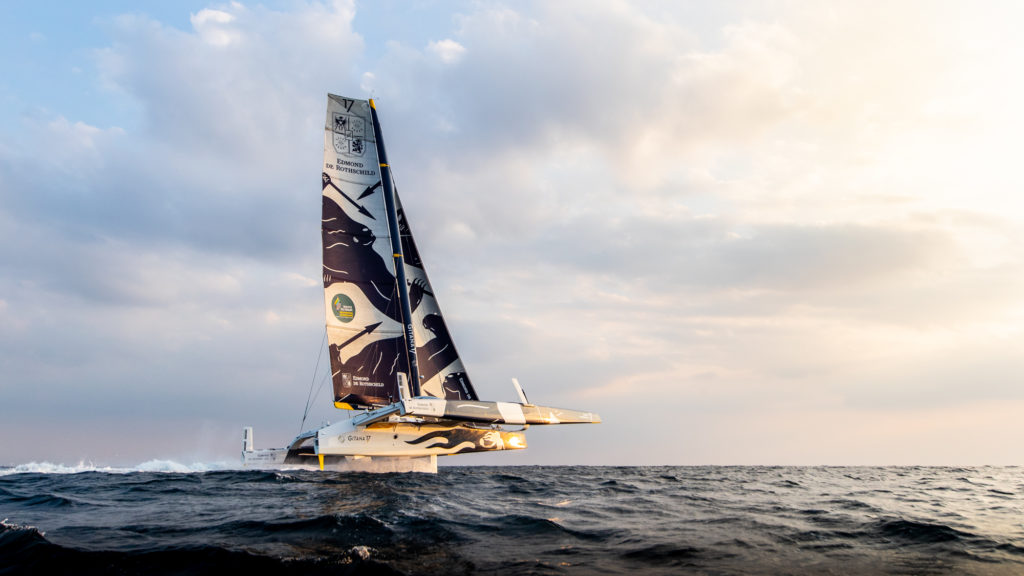
@Eloi Stichelbaut/ GITANA SA
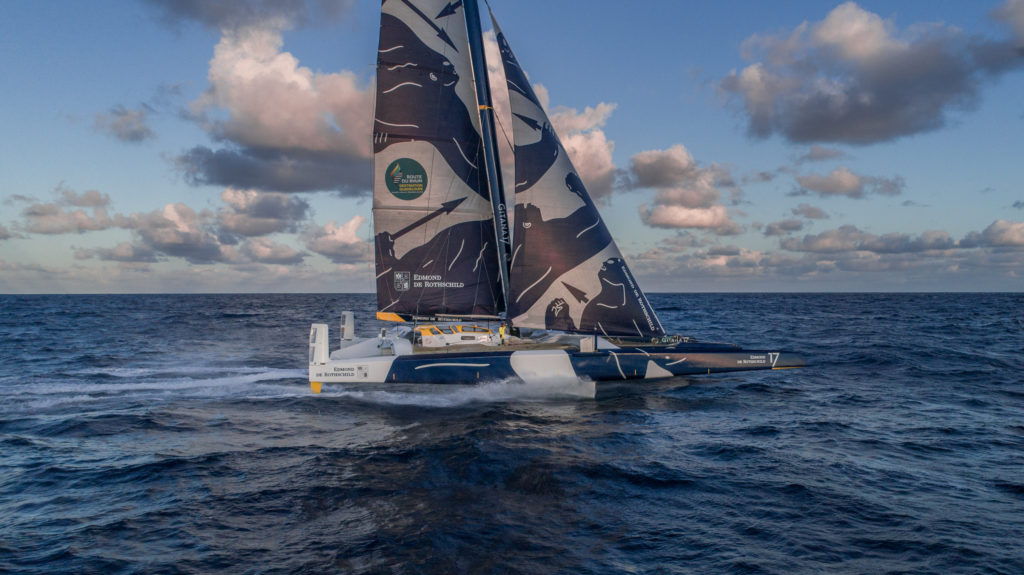
Specifications:
- Length: 32 m
- Draught: 37 m
- Displacement (weight) : 15.5 tons
- Appendages : T-Foil Float Rudders (2) / L-Shaped Foils (2)/ Daggerboard on the central Hull (1) / T-Foil rudder on central hull (1)
- Sail area upwind: 450 m²
- Sail area downwind: 650 m²
Related articles:
“Gitana 17, it’s intense”
A maxi trimaran of a new generation
More projects ULTIMATES :
2018 – trimaran multi 70 – maserati, 2016 – maxi trimaran – gitana 17, 2016 – foiler – easy to fly, 2014 – 100 feet – comanche, 2012 – multi 50 pieds – arkema.

Yachting World
- Digital Edition

Six solo skippers ready to race 100ft foiling multihulls around the world
- January 4, 2024
Is this the most audacious race ever? Six skippers are getting ready to race 100ft foiling maxi trimarans solo around the world – James Boyd looks forward to the Arkea Ultim Challenge Brest

There are very few ‘firsts’ left in the world of sailing, but one such remaining barrier could be smashed when the Arkea Ultim Challenge Brest sets off from north-west France on 7 January 2024.
Since the Sunday Times Golden Globe in 1968/69 – the ‘impossible feat’ – there have been all manner of non-stop laps of the planet, from fully crewed Jules Verne Trophy and solo records, to races such as the single-handed Vendée Globe , and The Race in 2000 for fully crewed maxi-multihulls. This January sees a new pinnacle-of-pinnacles event: the first solo, non-stop, round the world race in Ultim trimarans. Six brave French skippers on their 100ft multihulls are entered.
The advancement in human endeavour and technology in this cutting edge area of sailing has been extraordinary. Thirty years ago we were in Brest for the first tentative Jules Verne Trophy attempts. Back then no one knew if sailing around the world in under 80 days was even possible: three boats set off and only one made it – Bruno Peyron’s maxi-catamaran Commodore Explorer in 79 days 6 hours.
Since then the record has been reduced by titans such as Peter Blake/Robin Knox-Johnston, Olivier de Kersauson, Loïck Peyron, Franck Cammas and, ultimately, Francis Joyon . In a quarter of a century, the record has halved with Joyon’s 105ft IDEC Sport setting the present benchmark of 40d 23h 30m 30s (at 26.85 knots average) five years ago.
You might assume that a solo around the world would be much slower, but Joyon destroyed this notion. In 2004, when the Jules Verne Trophy record was 63 days, he completed a lap in just under 73 days alone on his 90ft trimaran IDEC (also the first successful solo non-stop circumnavigation by a trimaran). The following year the UK ground to a halt for an afternoon, television dominated by live coverage of Ellen MacArthur’s arrival into Falmouth after she’d taken more than a day off Joyon’s time.

Gabart on his previous Macif Ultime. Photo: Rolex/Carlo Borlenghi
Thomas Coville took the time below 50 days in 2016 with 49d 3h, broken the following year by François Gabart ’s 100ft Macif , establishing the present solo non-stop record: 42d 16h 40m 3s (just 4% slower than Joyon’s fully crewed).
While these times are impressive, they are records set in optimum, carefully selected conditions (for the first two weeks at least), whereas the Arkea Ultim Challenge Brest is a race. The solo sailors will have onshore routers, but their departure day is set, and pace likely dictated by their opponents. It’s a very different test of man and machine.
“It is something new,” says Gitana’s Charles Caudrelier . “The first time racing around the world with these big flying boats. It is a bit like the first Vendée Globe – not quite the same because we know where we are going! But it is a bit of an adventure, and I’m happy about that.”

Armel le Cléac’h in solo mode on Maxi Banque Populaire XI. Photo: Benoît Stichelbaut
The contenders
Surprisingly, skippers at all stages of their careers are competing. Amiable sea-dog Thomas Coville will be 55 when the race sets off. There is almost no major event Coville hasn’t done, from the America’s Cup to winning the Volvo Ocean Race.
Having sailed ORMA 60s, Coville moved into the record breaking business on maxi trimarans and is now on his third, Sodebo having backed him continuously. Of the six skippers Coville is the most experienced racing Ultims single-handed and is laudable for his sheer tenacity – he finally set a solo round the world record on his fifth attempt, after 11 years of trying.
At the other end of the scale, it was a surprise to learn that SVR-Lazartigue will not be raced by François Gabart, the single-handed round the world record holder and the blue trimaran’s initial skipper. Instead, taking over for solo races will be 26-year-old Tom Laperche. An engineer and highly talented sailor, Laperche is a graduate of the classic French offshore racing pathway; and has been involved with SVR-Lazartigue since its launch, racing as Gabart’s co-skipper in the last two Transat Jacques Vabre .
Anthony Marchand, 38, has also newly taken on a campaign, replacing Yves le Blevec on Actual Ultim 3 (ex-Macif) in early 2023. Meanwhile an 11th hour entry is Eric Péron on Adagio , the previous Sodebo Ultim. The boat is something of a ‘Frankenstein’ creation – recycling the 2001 maxi-tri Geronimo with appendages from 2010 America’s Cup winner USA17 – but a fast one.

Thomas Coville, on Sodebo Ultime 3. Photo: Vincent Curutchet/Team Sodebo
“I’ve been preparing for this kind of thing for years now,” said Péron. I haven’t done much preparation on the boat, but for everything else, the boxes are ticked. So, in the short time I’ve got left before the start, I hope to become at one with the machine. What motivates me most of all is the fact that it’s an extreme race, and that’s why I want to take up the challenge. Obviously, I’m not leaving totally confident. But I’m not going to give up.”
In the absence of Gabart, the two favourites are likely to be Armel le Cléac’h on Maxi Banque Populaire XI and Charles Caudrelier on Maxi Edmond de Rothschild (Gitana 17) . Theirs are two of the best funded and oldest teams.
Banque Populaire first sponsored Joyon’s ORMA 60 in 1989 and has campaigned seven trimarans since, including building two Ultims. The team’s first Ultim had a disastrous 2018, before a final crash left it utterly destroyed during the Route du Rhum . Undeterred, the French bank set about building a replacement. Now, alongside SVR-Lazartigue, their two-year-old Maxi Banque Populaire XI is one of the newest Ultims.
SVR-Lazartigue and Banque Populaire XI are essentially VPLP designs (Ultim teams have their own in-house designers, engineers, aero- and hydrodynamists, foil and hydraulics experts), while Maxi Edmond de Rothschild is from Guillaume Verdier – Emirates Team New Zealand’s long term naval architect who has applied much of his Cup experience to the offshore trimaran .

Adagio, the previous Sodebo Ultim. Photo: Yvan Zedda
Impressive statistics
An Ultim’s length can be anything from 24-32m (78ft 8in-105ft) with a maximum beam of 23m (75ft), though in practice all six are trimarans built to, or near to the rule’s maximum. Overall mast height is less than 120% of length of the longest hull, so 38.4m (126ft). Additional rules cover minimum air draught below the beams and float volume. Water ballast, autopilots and automatic anti-capsize systems are permitted, but stored energy (produced by the crew) or the creation of inertial energy and computer or electromechanical assistance for adjusting any of the appendages is forbidden.
As with all things yachting, their quantum performance leap has come since going airborne. Today all six use a similar, complex foil configuration: on each hull is a rudder with an elevator where lift can be adjusted via a flap on its trailing edge. Midships in each float is a giant J-foil, which can be raised, lowered and its rake adjusted. Unique to the Ultims (apart from Adagio) is the daggerboard, which is fitted not only with a trim tab on its trailing edge to prevent leeway, but an elevator.

Maxi Edmond de Rothschild (Gitana 17). Photo: Yann Riou/Gitana
The foils and elevators are adjusted hydraulically in combination to alter, for example, fore and aft trim and ride height, depending upon the point of sail and sea state. Generally the aim is for the platform to have zero heel/pitch. Thanks to the rudder elevators the ride is very stable in pitch (unlike IMOCA 60s ), the foils effectively ‘locking’ the boat to the water.
Just as America’s Cup catamarans that raked their windward rudder elevator to produce downforce (like crew on the rail), so Ultims can produce downforce with their daggerboard elevator. According to Gabart this is vital: racing an Ultim solo is about maximising efficiency so, when a gust hits, the rake on the daggerboard elevator is increased, sucking the trimaran’s main hull down. “If you release the hydraulic main sheet, it takes five minutes to pump it in again,” explains Gabart. “With this, when you are sailing at 40 knots you can add two tonnes [of down force] in one second using minimal energy.”
With their latest substantially larger foils, Ultims can fly in less wind. Originally it required 15-20 knots of wind or 26-27 knots boat speed for Macif to fly, this is now down to 12-14 knots of wind and 21-23 boat speed for SVR-Lazartigue – remarkable considering an Ultim’s 15-17 tonne displacement.
It’s similar on Banque Populaire XI, says Armel le Cléac’h. “We fly in 12-13 knots of wind or 22-23 knots of boat speed. In 15-17 knots of wind we fly upwind at 27-30 knots – that is the big step. Compared to older Ultims like IDEC in the last Route du Rhum, it’s an 8-9 knot improvement.”

Actual Ultim 3, formerly Gabart’s Macif. Photo: Thierry Martinez
Such speeds permit Ultims to become ‘masters of the weather’ – to some extent at least – often travelling so fast that their skippers can choose the weather system they can sail in. Optimum conditions for an Ultim are 15-25 knots (more than this and the sea state becomes too choppy for foiling), so they aim at the sweet spot of weather systems (flat water ahead of a warm front), which they then ride, like a surfer on a wave.
Le Cléac’h says their top speed has been 47 knots, “But that is not an objective. We want to have a good average speed: 40-42 knots for one or two hours is very good. 35-37 knots for 24 hours is very good too.”
Riding a rocketship
So how can skippers handle such a monster-sized boat that is foiling single-handed? Autopilot technology has improved to extraordinary levels of accuracy. According to Gabart, once set up, speed sailing in a straight line is not much different between solo and crewed. “Upwind or downwind VMG you are a little bit better if you are steering and others are trimming. At 65-70° TWA it is no different.”
Naturally manoeuvres are slower alone. Gabart says that going from reefed to full main might take two minutes fully crewed, but at least 10 solo. Some technology helps, like Harken’s latest generation Air 900 winches and pedestal grinders with bespoke gearing for single-person operation.

The newest of the Ultims, SVR-Lazartigue is perhaps the most advanced design. Photo: Guillaume Gatefait
While foils and many sail controls are hydraulic (SVR-Lazartigue has 23 rams), the pedestals are able to drive twin hydraulic pumps – though it requires serious manpower: “80% of the grinding is for the hydraulics,” says Gabart. SVR-Lazartigue will race with just five sails, including main and J0-J3, two permanently rigged on furlers.
Sailing at such high speeds has several effects. With apparent wind factored in, on deck there is constantly storm force, or at best gale force, winds. Human beings cannot operate for long in this and so cockpit protection has drastically increased with some Ultims now fully enclosed.
On the latest Sodebo and SVR-Lazartigue these have moved forward. On the former, the ‘bridge’ is forward of the mast, USS Enterprise-style, while on the latter it is just aft of the mast, with jet fighter-style steering cockpits each side, complete with sliding canopies. The end result is that an Ultim’s crew rarely ventures outside, viewing the world via CCTV.
While foiling reduces hydrodynamic drag, all the teams have been focussed on reducing aero-drag. Crossbeams now have trailing edge fairings made from robust vinyl, while on SVR-Lazartigue, moving their ‘cockpit’ forward has enabled them to have an AC-style ‘deck sweeper’ boom where the deck creates an endplate for the foot of the mainsail (improving efficiency).

Tom Laperche steering, jet fighter-style, on SVR-Lazartigue. Photo: Guillaume Gatefait
To finish first…
For the teams, the principal hurdle of the Arkea Ultim Challenge Brest will be finishing. The major worry on such a long race is reliability. To prevent structural failures Ultims have load cells, the output from which is monitored in real time. Otherwise teams have simply been racing and sea trialling as often as possible in all conditions.
This year’s Transat Jacques Vabre’s heavier conditions were ideal, enabling the double-handed teams to really push the boats harder. While all the Ultims finished, some were in better shape than others, Maxi Edmond de Rothschild suffering rudder and foil issues while Sodebo Ultim’s starboard rudder sheared off after a collision with an underwater object.
“The main problem will be to have all of the boats finishing the race in good shape,” says Caudrelier, who says it will take a new approach from his previous crewed around the world races. “Always you push to the maximum, but this time you can’t do that and we will have to find a good balance between performance and safety for the boat. That is quite an interesting exercise and also managing a boat like this alone for 45 days.”
Éric Péron explains: “On these boats, a small incident can immediately put us out of the race, because nothing can be replaced on our own. The boat is so big that there’s not much we can do to fix it with what we’ve got on board.”
Antoine Gautier, head of the design office at Mer Concept (behind SVR-Lazartigue) adds that their enormously complex boat will be simplified: “We are going to have less systems on board to make it simpler and more reliable. There are some things which won’t make much difference on a round the world race.”

Armel le Cléac’h at Banque Populaire’s mission control/protected pod. Photo: Vincent Curutchet/ Hublot Sailing team
Capsize was once a major concern, but for Ultims today is – apparently – almost a non-issue. The multihulls are simply huge, and their rigs are now stepped almost two thirds of the way back from the bow, to prevent pitchpoling. As Gautier explains: “The boats are definitely safer than any multihulls before. There are no more pitchpoling issues and in terms of heel stability, you almost can’t heel because the leeward foil is pushing up so much. That is why they are able to sail so fast, even short-handed – because the boats are very safe and you don’t feel in danger.”
Nonetheless they do still have inclinometers which can automatically dump hydraulics (eg mainsheet) or mechanically release headsail sheets if heel is excessive.
Of greater concern are elements beyond the skipper’s control: collision. AIS and radar target alarms substantially reduce the chance of an Ultim hitting another vessel, but the threat of a ‘UFO’ (unidentified floating object) remains. As Gautier says: “Collision is the biggest fear for all of us. If you hit something at 30-plus knots it is the end of your race. The boat which is going to win will be the one which has all its appendages at the finish. It is Russian roulette and you can’t do anything about it. This is not a fun part of the sport, but it is the same for any race like this.”
To help prevent such collisions Ultims are all fitted with SEA.AI (previously known as OSCAR) a camera mounted at the masthead that can ‘see’ ahead both in daylight and at night, using infra-red. Images are compared in real time with a giant database to establish whether something ahead represents a collision threat.

Ultims raced each other double-handed in the November 2023 Transat Jacques Vabre – won by Armel le Cléac’h/Sébastien Josse in Banque Populaire XI. Photo: Jean-Marie Liot/Alea
There are other factors too that will come into play: a good deal of luck, undoubtedly, but also the skill, experience and motivation of the skippers. Caudrelier has perhaps the most experience in his boat and over the last three years has won most races, but he has never raced solo around the world. “This is my Vendée Globe” he acknowledges.
By contrast Le Cléac’h has completed three Vendées, on the podium every time. However his recent victory in the Transat Jacques Vabre was his first in an Ultim. For Coville, this might be his last lap? While for Laperche this will be his first big Ultim event and proving himself is a key objective.
What is certain is that this will be the ultimate contest between some of the world’s most talented offshore sailors. How many will make it round? And for those that do, it could be the fastest ever round the world race, so all the action will unfold quickly. Follow at arkeaultimchallengebrest.com
If you enjoyed this….
Yachting World is the world’s leading magazine for bluewater cruisers and offshore sailors. Every month we have inspirational adventures and practical features to help you realise your sailing dreams. Build your knowledge with a subscription delivered to your door. See our latest offers and save at least 30% off the cover price.

The global authority in superyachting
- NEWSLETTERS
- Yachts Home
- The Superyacht Directory
- Yacht Reports
- Brokerage News
- The largest yachts in the world
- The Register
- Yacht Advice
- Yacht Design
- 12m to 24m yachts
- Monaco Yacht Show
- Builder Directory
- Designer Directory
- Interior Design Directory
- Naval Architect Directory
- Yachts for sale home
- Motor yachts
- Sailing yachts
- Explorer yachts
- Classic yachts
- Sale Broker Directory
- Charter Home
- Yachts for Charter
- Charter Destinations
- Charter Broker Directory
- Destinations Home
- Mediterranean
- South Pacific
- Rest of the World
- Boat Life Home
- Owners' Experiences
- Interiors Suppliers
- Owners' Club
- Captains' Club
- BOAT Showcase
- Boat Presents
- Events Home
- World Superyacht Awards
- Superyacht Design Festival
- Design and Innovation Awards
- Young Designer of the Year Award
- Artistry and Craft Awards
- Explorer Yachts Summit
- Ocean Talks
- The Ocean Awards
- BOAT Connect
- Between the bays
- Golf Invitational
- Boat Pro Home
- Pricing Plan
- Superyacht Insight
- Product Features
- Premium Content
- Testimonials
- Global Order Book
- Tenders & Equipment
Video: Flying on the world’s largest foiling trimaran
Sailing team Gitana has released an on board video showing its new 32 metre maxi trimaran Edmond De Rothschild flying on her hydrofoils. As the footage below shows, all three hulls were lifted clear of the water on her sea trials despite weighing a total of 15.5 tonnes.
Speaking after a successful day on the water, Sébastien Josse of Gitana said, “We immediately saw that the boat was keeping her promises: stiff and safe and begging to unleash her power. The first time the boat took off was an incredible moment.
“We had 15-17 knots of breeze and flat seas, with waves of less than a metre — everything was in place to fly. Aboard the boat there was a mixture of excitement and surprise, as well as pride,” he added. “Even though we're only at the start, it's hugely satisfying to see that we're heading in the right direction.”
Launched back in July in the French port town of Vannes, Edmond De Rothschild has spent three years in development. Continuing their family’s sailing legacy, namesake descendants Ariane and Benjamin de Rothschild were involved in the fit-out stage.
Built for speed, she lacks the creature comforts found on a multihull superyacht , but with an LOA of 32 metres, Edmond De Rothschild is the largest purpose-built foiling trimaran in the world — and more than double the length of the AC45 racing catamarans that competed at the America's Cup in Bermuda earlier this summer.
The ultimate aim is that Edmond De Rothschild will singlehandedly circumnavigate the globe in 2019-20. Before then, the team has set the intermediary goal of racing in the 2017 Transat Jacques Vabre, which departs from Le Havre on November 5.
Foiling technology was thrust into the global spotlight in 2013 during the 34th America’s Cup in San Francisco and with the format of the 36th America’s Cup still undecided it is likely that the Royal New Zealand Yacht Squadron will be watching these developments with great interest.
More stories
Most popular, from our partners, sponsored listings.

Gitana 17, large flying offshore trimaran
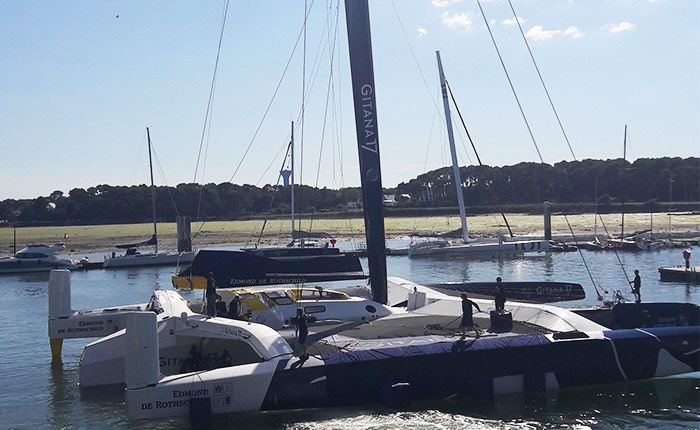
The maxi trimaran Gitana 17 Edmond de Rotshild of the Gitana team, precursor of a new generation of multihulls designed to glide and fly offshore, has joined its home port in Lorient.
The Gitana 17 and its skipper Sébastien Josse , who entered the first edition of the Brest World Ultim Tour in 2019, will take part in the Transat Jacques Vabre in November 2017 and the Route du Rhum in 2018.
Guelt Nautic is proud to have taken part in this great technological adventure with the machining of the mast base of a 32-metre long, 23-metre wide and 37-meter high giant carbon mast.
Learn more : Gitana Team

- CLASSIFIEDS
- NEWSLETTERS
- SUBMIT NEWS
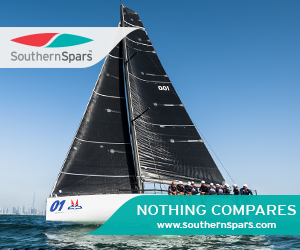
The Gitana lineage continues
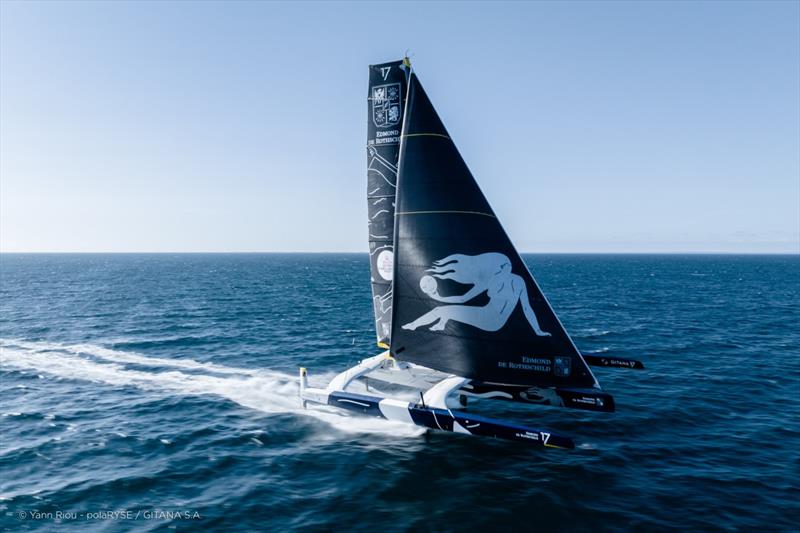
Related Articles
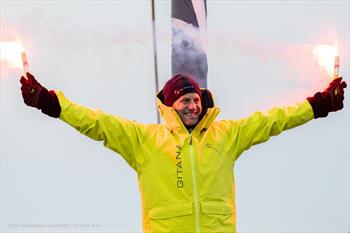
Fresh organisation for the Rhum
“This is the fourth launch I’ve experienced as skipper of Gitana, but this one’s a bit special” , admitted Charles Caudrelier. Indeed this 2022 sports season, the high point of which will unquestionably be the legendary Route du Rhum, marks a change of organisation for the five-arrow racing stable and opens a whole new chapter in the Maxi Edmond de Rothschild story. In 2019, the decision to have a duo at the helm of the 32-metre giant was much talked about. However, this bold gamble has proven to be a pertinent choice; for three seasons, from 2019 to 2021, Franck Cammas and Charles Caudrelier have virtually won it all in both double-handed and crewed configuration: Rolex Fastnet, Brest Atlantiques, Drheam Cup, Transat Jacques Vabre… Five victories out of the six races contested! In early 2022, in light of the upcoming ‘solo’ programme, Franck Cammas was keen to develop his status within Gitana Team to invest his time and energy on other craft. As such, he has become a consultant for Gitana Team and will provide technical support to Charles for his Rhum preparation, but the sailor of the decade will no longer share the helm with his partner.
“It’s a major change and I’m effectively losing a very valuable co-skipper in Franck. He won’t be very far away though and will provide support onshore and at sea throughout my preparation. His massive amount of experience and his extensive multihull knowledge will be precious assets. In 2010, I routed him for his victory so I hope the roles will be reversed this year… The Route du Rhum is the challenge that has kept running through my head since my arrival within Gitana Team. This race is the equivalent of our Olympic Games on a multihull. The major double-handed races have been perfect training because sailing as a duo is essentially part-time singlehanded sailing… but I’m really looking forward to rediscovering the singlehanded format as I’m particularly fond of it. On a multihull, it’s the skipper who really makes a difference. It’s down to me to find the best combination so I can set the bar as high as possible in six months’ time. I need to get out sailing, link together sessions out on the water in false solo and then alone over 2 days, 4 days… My overriding emotion is one of eagerness and excitement rather than stress. The Route du Rhum is a dream come true for me and I’ve been working towards this for over three years.”
Within the pool of talent gathered together in Gitana’s Jules Verne crew, Charles Caudrelier has put together a set of top-flight guardians to ensure he leaves nothing to chance in his preparation… A member of the crew early on and someone cherished for his unrivalled feel for the helm and his shrewd acumen when it comes to getting the boat slipping along, Morgan Lagravière will be stepping up his presence within the team henceforth. Training partner to Charles Caudrelier, he will be his replacement skipper for the Route du Rhum. Erwan Israël, a trusted crewman and a genius router (in tandem with Stan Honey, editor’s note) in the last victorious Transat Jacques Vabre with the duo Cammas – Caudrelier, will perform the same role in the Route du Rhum, as well as being in charge of the performance analysis year round, which is such a crucial post on this type of machine. Naturally, David Boileau, boat captain on the Maxi and a key piece in the jigsaw, as well as Yann Riou, the media crew who needs no introduction, will complete the set-up.
A Maxi Edmond de Rothschild optimised for solo sailing
“The boat was in refit for five months because during my return from Fort-de-France in solo format we unfortunately damaged the centreboard and lost our skate wing in a collision. The winter months have been put to good use to carry out a thorough check of the platform, its various systems and all the appendages, which make up Gitana 17’s underwater artillery. Every possible element has been dismantled, checked, cleaned and changed where there was wear or damage. That’s part and parcel of a winter refit, but it’s vital in terms of reliability,” explained the skipper.
“The appendages – the manufacture of new ones, the repair of the old ones to provide spare parts – has also been a major part of this 2022 refit. To the naked eye, nothing spectacular has gone on, but the level of maturity of the platform and the team in its understanding of the boat have enabled us to go into every detail in great depth. It’s these details which make a difference. With the Maxi Edmond de Rothschild, we’re constantly evolving! At Gitana, we’ve always dared to take things to the next level, and I believe that it’s this boldness, which has enabled us to keep a few steps ahead of the game in certain areas. The competition is fierce, which is highly motivating and it certainly has more potential for development than us today. However, our technical maturity and experience on this boat will hopefully be our strengths.”
In accordance with the original specifications, the Verdier design cockpit has been devised and designed for singlehanded and crewed racing, which is a definite advantage when it comes to switching from one mode to the other in a matter of weeks. As such, the only new element aboard is a solo seat specially manufactured and moulded for Charles Caudrelier. In solo configurations, it’ll replace the second pedestal and enable the sailor to helm, trim and keep watch, snug at the very centre of the cockpit. This gain in comfort is bound to transform into a gain in performance.
“A huge amount of work has gone into the autopilot with our in-house electronics engineer, Nicolas Le Griguer, and the Pixel sur Mer teams, with whom we’ve been working exclusively on these very specialised aspects since the Maxi was created. It will be helming for 99% of the Rhum, so it’s an ally which cannot be overlooked,” mused Charles Caudrelier.
Finally, a brand-new sail wardrobe will adorn the Maxi Edmond de Rothschild . This new addition will accompany a change of style or rather an evolution in the warrior livery devised by the American street artist Cleon Peterson in 2017. After a few test sails to give the boat a shakedown at the start of the season, Charles Caudrelier will quickly head offshore and get as much time on the water as he can in shorthanded and solo format. Indeed, the skipper must complete his qualification for the Rhum, which equates to a total of 1,200 consecutive miles in solo configuration. Two crewed races are then lined up for the team in July, which will serve as the perfect dress rehearsal for the group of six sailors who will set sail on the quest for the Jules Verne Trophy at the end of the year. From late summer onwards, the game plan will involve a steady work-up for the major meeting in Saint Malo, which is already on everyone’s minds.

2022 race programme
Tuesday 10 May: Launch of the Maxi Edmond de Rothschild
Friday 1 July: Start of the Finistère Atlantique (3,500-mile crewed race starting and finishing in Concarneau via the Canaries and the Azores)
Sunday 17 July 2022: Start of the Drheam-Cup (1,500 miles from Cherbourg en Cotentin to La Trinité-sur-Mer via the Fastnet and Bilbao)
Sunday 6 November: Start of the Route du Rhum Destination Guadeloupe (3,543 miles in solo format from St Malo to Pointe-à-Pitre)
Mid-December: Standby for a Jules Verne Trophy record attempt (21,700 miles starting and finishing in Brest via the three major capes of Good Hope, Leeuwin and the Horn)
Charles Caudrelier // Born on 26 February 1974 in Beg-Meil, Brittany
On 6 November 2022, Charles Caudrelier will take the start of the legendary Route du Rhum. Despite a whole string of accolades from a career spanning over 20 years, which is as abundant as it is varied, punctuated by a slew of prestigious victories in both singlehanded and crewed format, on monohulls and multihulls, in France and internationally, the native of Beg-Meil will be competing in his very first Route du Rhum. A rookie in the very closed circle of skippers of flying Ultim maxi-trimarans! At the helm of the Maxi Edmond de Rothschild , a pioneer of this new generation and one of the most honed boats of the fleet, Charles Caudrelier will be the man to beat. A status which he assumes without qualms and a major meeting, a lifelong ambition in his words, which he is approaching with relish and determination.
- o 1st rookie in the Solitaire du Figaro in 1999 o Winner of the Trophée BPE in 2001 with Gildas Morvan o Winner of the Tour de Bretagne in 2001 with Gildas Morvan o Winner of the Solitaire du Figaro in 2004 o Winner of the Transat Jacques Vabre in 2009 with Marc Guillemot o Winner of the Volvo Ocean Race in 2011-2012 on Groupama 4 o Winner of the Transat Jacques Vabre 2013 with Sébastien Josse on Gitana XV o 3rd in the Volvo Ocean Race 2014-2015 on Dongfeng Race Team (skipper) o Winner of the Volvo Ocean Race 2017-2018 on Dongfeng Race Team (skipper) o Sailor of the year 2018 o Winner of the Brest Atlantiques in 2019 on the Maxi Edmond de Rothschild with Franck Cammas o Winner of the Fastnet Race in 2019 and 2021 on the Maxi Edmond de Rothschild with Franck Cammas o Winner of the Drheam Cup 2020 on the Maxi Edmond de Rothschild with Franck Cammas o Winner of the Transat Jacques-Vabre in 2021 on the Maxi Edmond de Rothschild with Franck Cammas
- 0 No item in your cart
- SUBSCRIPTION
- Classified Ads
- Technical Specifications
- Destinations
- Address book

- All the magazines

Article published on 01/06/2017
By Jean-Christophe Guillaumin
published in n°154 july / aug.

You will have to wait a few more weeks to discover the brand new Gitana 17, whose launch is planned for next July.
Create a notification for "News from the builders"
We will keep you posted on new articles on this subject.
At 32 meters long and 23 wide, the trimaran only just fits into the Ultime class, and was designed by Guillaume Verdier and his team, in close cooperation with Gitana’s design team. The idea behind this innovative boat is to be the precursor of the new generation of racing boats. The team’s stated ambition is in fact that by 2020, Gitana will be the first flying ocean racing maxi-multihull! The planing, innovative hulls, T-shaped rudders, L-shaped foils, very carefully studied platform aerodynamics – everything aboard Gitana 17 speaks of flying.
The trimaran has been designed for a singlehander, but should be easily adaptable for fully crewed sailing, and record attempts, notably around the world.
The boat’s first race will be the Jacques Vabre transat, when the skipper, Sébastien Josse, will be accompanied by Thomas Rouxel for this tricky, hotly-disputed event.
A few figures, always impressive: 20 months construction – 170,000 hours’ work – 32m long – 23m wide – 650m² of downwind sail – 450m² to windward – displacement: 15.5 tonnes – air draft: 37 m.
For more information: www.gitana-team.com
Did you like this article ?
Share this article
Most-read articles in the same category.
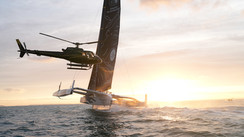
Arkea Ultim Challenge - Brest: Charles Caudrelier's coronation aboard his Maxi Edmond de Rothschild
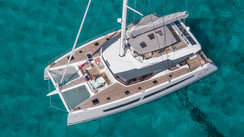
Alegria 67 - A Jacuzzi at La Grande-Motte?
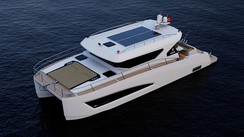
Discovery 40 - A sedan built in Turkey
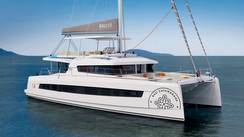
Bali 5.8 - The new flagship of the range
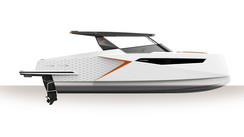
Dracan 42 - Another manufacturer on the powercat market!
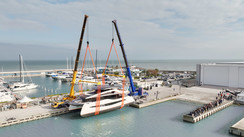
WiderCat 92 - First model just launched
What readers think.
Post a comment
No comments to show.
Follow us on
Vous avez ajouté " " à vos favoris., vous avez supprimé " " de vos favoris., in order to add this article to your favorites, please sign in..
All your favorite teams and sources in one place
Your Teams. All Sources.
© 2024 BVM Sports. Best Version Media, LLC.
Ariane de Rothschild Carries Forward Gitana Team’s Legendary Lineage in Sailing with the New Maxi Edmond de Rothschild
Ariane de Rothschild, heiress to the Gitana maritime saga, has announced the construction of a new Maxi Edmond de Rothschild, a large offshore racing trimaran. This new generation maxi-multihull, built by CDK Technologies and designed by a unified Verdier/Gitana design team, will be launched in 2025. The new Maxi Edmond de Rothschild will adhere to the Class's architectural framework but also retain freedom in targeted developments. The emphasis will be on improving the "motor" (sails and everything above deck) and limiting drag. The new boat will be designed for single-handed and crewed sailing, races, and records. It will prioritize enhanced aerodynamics and hydrodynamics, with a focus on getting airborne sooner and improved performance at high speed in heavy seas.
The announcement of the new Maxi Edmond de Rothschild demonstrates the commitment of the Gitana Team to continue their maritime legacy and technological innovation. The development of this new generation maxi-multihull signifies a bold step forward in offshore racing and the ongoing pursuit of increasing performance levels in the sport.
- The new Maxi Edmond de Rothschild will be a 32-meter long and 23-meter wide ULTIM trimaran.
- The boat is set to be launched in September 2025.
- The Maxi Edmond de Rothschild and her competitors are currently preparing for the Arkea Ultim Challenge - Brest, the first single-handed race around the world for the ULTIM category, scheduled to start on January 7, 2024.
- The new Maxi Edmond de Rothschild will be built by CDK Technologies, a departure from the team's usual shipyard choice, and is set to be launched in September 2025.
The announcement of the new Maxi Edmond de Rothschild highlights the Gitana Team's ongoing commitment to pushing the boundaries of offshore racing. This new generation maxi-multihull represents a significant milestone in the team's pursuit of innovative technology and enhanced performance in the sport.
The summary of the linked article was generated with the assistance of artificial intelligence technology from OpenAI
www.sail-world.com • Gitana Team
The Gitana lineage continues
Think your team or athlete is better show us, submit your story, photo or video.

We use cookies to ensure that we give you the best experience on our website. If you continue to use this site we will assume that you are happy with it.
OK Privacy policy

“Gitana”, the maxi-trimaran designed as a work of art
The Arkéa Ultim Challenge starts this Sunday in Brest, and, once again, “Gitana” will catch the eye. The fresco adorning this maxi-trimaran, imagined as a work of art, is exhibited in the basement of the Palais de Tokyo.
Coverage Details
Bias distribution.
- There is no tracked Bias information for the sources covering this story.
To view factuality data please Upgrade to Premium
To view ownership data please Upgrade to Vantage
Similar News Topics

- Allures yachting
- Garcia yachts
- Dufour yachts
- Fountaine Pajot Sailing Catamarans
- Outremer catamarans
- Allures Sailing Catamarans
- Garcia Explocat
- Dufour catamarans
- Aventura catamarans
- NEEL Trimarans
- Fountaine Pajot Motor Yachts
- Garcia trawler
- Beneteau Motorboats
- Aventura Power Catamarans
- Yacht school
New giant trimaran hydrofoil Gitana 17
On July 17th, the revolutionary Gitana 17 100-foot ocean hydrofoil trimaran, designed by one of the most sought-after designers Guillaume Verdier and built by Multiplast for Baron Edmond de Rothschild, was unveiled in Lorient.
Gitana 17 / Maxi Edmond de Rothschild
The most radical of the new Ultime-class trimaranes, incredible Gitana 17 or Maxi Edmond de Rothschild originally designed for solo round the world race Volvo Ocean Race 2019 with a maximum speed of up to 50 knots.
Ultime class Gitana 17 hydrofoil maxi trimaran
According to Verdier, Gitana 17 may even exceed the set speed limits one day. The trimaran is also capable of overcoming the waters of the Southern Ocean in displacement mode at speeds up to 40 knots. However, the main goal of the designers is still to improve the average speed potential of the boat, which is up to 900 miles per day, although a much larger 130-foot catamaran Banque populaire v , currently holds a record of 908 miles.
The trimaran is the culmination of three years of team work and integrates model improvement IMOCA 60s for Vendée Globe, and MOD70 for America's Cup ... It differs significantly from other yachts in the class Ultime , such as Macif François Gabart and Sodebo Thomas Coville. The Gitana 17 is a bit heavier as it has more fender control systems, more hydraulics, and a stiffer platform in the torsion bar.
The trimaran has giant L-shaped hydrofoils as well as retractable T-shaped on the central building. These wings are much larger than any other yacht. The trimaran is 32 meters long, 23 meters wide, and the newly installed mast is 35 meters high.
Maxi hydrofoil trimaran Gitana 17 class Ultime / Maxi Edmond de Rothschild
These concepts were developed before 2014-2015 for Gitana 15 and MOD70 now known as Maserati. The team installed a single hull with multiple wing shapes to understand their effectiveness on the water. T-shaped krill steering wheels on outer hulls - ingenious and sophisticated solution developed by the team Gitana . They are equipped with lifters for trimaran adjustment and are controlled by a computer controlled hydraulic system. The windward rudder is highly susceptible to shock waves, so it can be lifted, locked in the housing, and disconnected from control systems.
This ambitious project testifies to the passion for innovation and performance of the entire team of its creators. The first transatlantic race for Gitana 17 scheduled for November this year. For this trial run Sebastian Hosse will accompany Thomas Rousel , and next year it is planned to participate in The Route du Rhum 2018 and then Volvo Ocean Race 2019 .
News and articles

The other day, a plant for the production of inflatable boats in Nikolaev was destroyed. At the same time, the invaders are not going to stop and continue to wage a senseless and merciless war against the “windmills”. This time their goal was the Adzhigol lighthouse.

During the 300 years that yachting has officially existed as a form of leisure, it has attracted a variety of people. Aristocrats and sportsmen, rich men and enthusiasts, writers and artists were fond of sailing ships. This article is about the trail that yachting left in the work of such famous impressionist painters as Claude Monet, Pierre Auguste Renoir and Gustave Caillebotte. Claude Monet and his Argenteuil [...]

Most newly built boats are already equipped with light-emitting diode (LED) lighting. But if your boat is old enough or you are considering buying a used boat, then the lighting may need to be updated. Interparus will give a couple of simple tips for those who are going to update the lighting.


IMAGES
COMMENTS
Overnight, he'll finally point the bows of the five-arrow maxi-trimaran northward, where a long tack offshore of the Brazilian coast awaits. News. 10 février 2024, 17h19. ... the passage meant a great deal to the skipper of Gitana Team. The first maxi-trimaran designed to fly in the open water, the Maxi Edmond de Rothschild will always be ...
Le premier grand trimaran de course au large conçu pour voler en haute mer. Six ans plus tard, l'équipe annonce sa descendance. Une nouvelle monture volante signée par un design team unifié Verdier/Gitana et construit à Lorient par CDK technologies. Ce maxi-multicoque de nouvelle génération verra le jour courant 2025.
Gitana 17 is a 32m fully foiling trimaran built to a Verdier design to compete in both crewed (by a team of six) and solo races and record attempts. Skippered by Charles Caudrelier, it has won the ...
Gitana 17 the revolutionary 100ft maxi trimaran designed to fully foil in the open ocean at speeds up to 50 knots. Become a FREE SUBSCRIBER to Yachting Wor...
Exclusive tech tour of the Gitana 17/Maxi Edmond de Rothschild Ultim by skipper Franck Cammas and Charles Caudrelier after their line honours win in the 2021...
Maxi-multicoque - 32 m. Dessiné par l'architecte Guillaume Verdier et son équipe en collaboration avec le bureau d'études Gitana, le Maxi Edmond de Rothschild est à la croisée des chemins entre un bateau archimédien et une unité volante. Il est le premier maxi-multicoque de course au large conçu pour voler en haute mer.
The most radical of the new Ultime trimarans, the incredible Gitana 17 is designed to foil at over 50 knots and cross up to 900 miles a day, crewed by just one solo skipper. Elaine Bunting talked ...
A maxi trimaran for Edmond de Rothschild. A trimaran measuring 32-metres in length and 23 metres in width, this 'Ultime' once again bears witness to the passion for innovation and performance, that serves as a daily guide to Ariane and Benjamin de Rothschild and the rest of the Gitana Team. They created the offshore racing stable in 2000 ...
The Maxi Edmond de Rothschild Trimaran will attempt The Jules Verne Around The World Trophy starting on standby November 1st, 2020.From The Gitana Team: "The...
The Maxi Edmond de Rothschild is unveiled. "This Thursday 30 March, the Gitana Team invited the press to the Palais de Tokyo museum in Paris to mark the official launch of the Maxi Edmond de Rothschild, a giant' measuring 32 metres long and 23 metres wide, which is undergoing her final few months in the yard after a build process spanning ...
Launched in 2017, Gitana 17 paved the way for a new generation of maxi-trimarans. Boasting the catchline "aiming to fly around the world", the Verdier design, created and designed to navigate the open ocean, was really setting the tone from her opening tacks.
The first racing trimaran was the former Elf III, now Gitana IX (Designed by G.Ollier - Multiplast). Then came the first boat entirely developed by the team: Gitana X. ... Arkea Ultim Challenge - Brest: Charles Caudrelier's coronation aboard his Maxi Edmond de Rothschild On01/03/2024 00:00 News UpWind - A selection program for women sailors ...
Six skippers are getting ready to race 100ft foiling maxi trimarans solo around the world - James Boyd looks forward to the Arkea Ultim Challenge Brest. There are very few 'firsts' left in ...
Initial sensations aboard Gitana 11. Since the new Gitana 11 was launched on 7th September, Yann Guichard and the Gitana Team's technical crew have been out for a number of test sails aboard the 77 foot maxi-trimaran. Indeed, whilst the base has remained the same and is a known quantity, the transformation of various sections of the multihull ...
Sailing team Gitana has released an on board video showing its new 32 metre maxi trimaran Edmond De Rothschild flying on her hydrofoils. As the footage below shows, all three hulls were lifted clear of the water on her sea trials despite weighing a total of 15.5 tonnes. Speaking after a successful day on the water, Sébastien Josse of Gitana ...
The maxi trimaran Gitana 17 Edmond de Rotshild of the Gitana team, precursor of a new generation of multihulls designed to glide and fly offshore, has joined its home port in Lorient.. The Gitana 17 and its skipper Sébastien Josse, who entered the first edition of the Brest World Ultim Tour in 2019, will take part in the Transat Jacques Vabre in November 2017 and the Route du Rhum in 2018.
In the summer of 2017, Gitana Team unveiled the Maxi Edmond de Rothschild: a pioneer! The first large offshore racing trimaran designed to fly in the open ocean. Six years on, the team is announcing her descendant. A new flying steed created by a unified Verdier/Gitana design team and built in Lorient by CDK Technologies.
Wednesday 11 May 2022. The Maxi Edmond de Rothschild relaunched. Early yesterday morning, the large doors to the Gitana shed were opened to release the Maxi Edmond de Rothschild from her five-month refit. Enjoying a ringside seat, her skipper, Charles Caudrelier, looked on attentively, though his mind is already geared towards the open ocean ...
The team's stated ambition is in fact that by 2020, Gitana will be the first flying ocean racing maxi-multihull! The planing, innovative hulls, T-shaped rudders, L-shaped foils, very carefully studied platform aerodynamics - everything aboard Gitana 17 speaks of flying. The trimaran has been designed for a singlehander, but should be easily ...
Fin de l'été place à l'automne, la saison qui verra le Gitana Team s'élancer à l'assaut de son 1er Trophée Jules Verne. Pour marquer cela, des nouvelles imag...
Ariane de Rothschild, heiress to the Gitana maritime saga, has announced the construction of a new Maxi Edmond de Rothschild, a large offshore racing trimaran. This new generation maxi-multihull, built by CDK Technologies and designed by a unified Verdier/Gitana design team, will be launched in 2025.
"Gitana", the maxi-trimaran designed as a work of art. The Arkéa Ultim Challenge starts this Sunday in Brest, and, once again, "Gitana" will catch the eye. The fresco adorning this maxi-trimaran, imagined as a work of art, is exhibited in the basement of the Palais de Tokyo.
Ultime class Gitana 17 hydrofoil maxi trimaran. According to Verdier, Gitana 17 may even exceed the set speed limits one day.The trimaran is also capable of overcoming the waters of the Southern Ocean in displacement mode at speeds up to 40 knots.